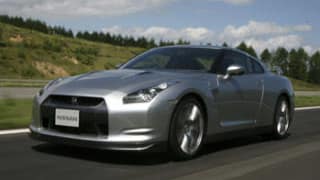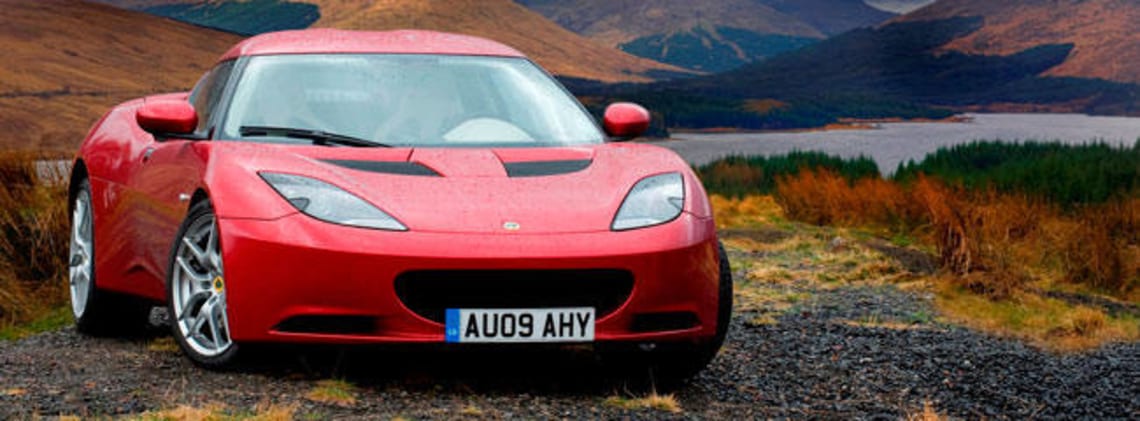
Nissan GT-R 2010 Review
A saturated Phillip Island circuit is a long way from the Nurburgring, but for Nissan test driver...
Browse over 9,000 car reviews

When you're the sort of carmaker that goes 15 years without a fresh model line, then the wheels you eventually roll out are going to get a lot of scrutiny. So it is the Lotus Evora, which went on sale here in January. The Evora moves Lotus away from sole reliance on the Elise in all its guises, and means the British brand has something up-market and comfortable to offer.
Unlike the tiny track-focused Elise (and hardtop Exige variant), the Evora is sufficiently civilised for the daily commute: a rival for the class benchmark, the Porsche 911, only more exclusive. Or at least that's the theory. The reality is a bit more complicated.
The good news about the Evora is that it feels utterly like a Lotus. Unfortunately, the bad news is also that it feels utterly like a Lotus. The Evora is Lotus's first proper crack at a luxury model since the Esprit was finally deleted nearly a decade ago.
I have never so much as sat in an Esprit, so I've no idea what the Lotus track record is like at the elite end of the market. However, it's immediately obvious that the Evora has the same non-mainstream feel that distinguishes the Elise. There are compromises here that volume carmakers have long since left behind.
For example, in supercharged versions of the Elise and Exige, rear vision is almost nonexistent thanks to the engine plumbing. It can make life awkward, but oddly it's also part of the charm.
I didn't expect to find a similar problem in the Evora, in which half the tiny rear window is obscured by the engine. At this level, that doesn't feel good enough. It adds a layer of difficulty to the usual problems of seeing out of a coupe which here, as usual, involve reflections off the dashboard on to the front glass.
To solve the rear vision problem, the Evora can be fitted with a rear camera and parking sensors. These come bundled into one of the three options packs, and the test car -- in common with the first 1000 Launch Edition cars -- was fitted with the lot.
On a normal Evora, that would nudge the price up to almost $200,000, where the alternatives for buyers get really interesting. Desirable performance cars from all the German brands would leave you with change.
Of course, you could buy the Evora without all the trimmings. A stripped-out Elise is still an appealing prospect because it's essentially a toy. However, I couldn't imagine buying an Evora without most of the goodies. And then the problem becomes that some of the goodies aren't very good.
Chief among them is the premium Alpine satnav and audio system, which looks after-market and has poorly resolved graphics, screen-saver aside. It's part touchscreen, part button-operated and simple things -- adjusting volume, for example -- are a pain. The buttons are minuscule and the system logic inscrutable. This $8200 option is bundled with cruise control, parking sensors and Bluetooth for the phone, all of which would be difficult to do without.
Something I could probably do without are the rear seats, which cost another $7000. They are useless for adults or children larger than infants, and even then I wouldn't want the job of installing them. They work for luggage, although cargo space is what you get anyway if you don't tick the box.
It's certainly handy to have space behind the seats because other storage options, boot included, are small. Supposedly, the boot has aircon channelled through it to prevent the engine cooking your shopping. Unfortunately, it doesn't work.
The luxury option pack adds more leather to the cabin and it's offset by good-looking metal dash trim plus one or two classy ingredients, such as the gearstick. But many other bits, such as the pedals and vents, appear to have been carried over from the Elise and the quality of finish still trails the mainstream, with a poorly fitting passenger airbag cover in the car I drove.
Unique to the Evora is a steering wheel that adjusts in two directions and aircon with settings other than hurricane and off. The seats adjust only for distance and backrest angle, but these Recaros are comfortable all day.
The main driving position problem involves the pedals, which are offset towards the centre of the car in a way most makers can avoid these days. The clutch has a fairly strong spring, the gearshift action is mechanical and the brake pedal has extremely short travel. But they are nicely grouped and pleasing to use with a little familiarity.
The steering wheel is suitably small and hydraulic assistance means that, unlike the Elise, the Evora doesn't have to be wrestled into a parking spot.
However, the instruments are awkward to read, with speedo increments at 30km/h, 60km/h and so on, then a halfway mark between. Does this indicate 45km/h? Tiny red display panels on either side of the dials are difficult to see in any light conditions and the trip computer functions they display are rudimentary. Also irritating are windows that don't drop all the way into the doors, or auto-up.
Getting into an Elise is impossible for many and, although the Evora sills are narrower, ingress will still be a challenge for some because it's so low to the ground.
One big lift over the smaller Lotus cars involves interior refinement, with much less engine noise in the cabin. There's tyre roar and thump and occasional metallic thunks, but fewer of them and they're less noticeable.
Ride is another advance, with a sophisticated feel that's on the acceptable side of brittle for a sports car. Despite this, the Evora would be frustrating to live with day-to-day and the difference between it and an Elise is a matter of degree, rather than kind.
Of course, that's also the good news. Take the Evora on a long country drive and you won't want to get out. On the right road at around the legal limit, the Evora comes alive.
The chassis is gorgeous and seems to respond intuitively to small inputs from the throttle and steering. It quickly adopts a balanced stance for fizzing around bends without any effort from the driver.
There's a delicacy to its movements that's every bit as engaging as an Elise, only the Evora has more poise and feels less frenetic. The Evora is also less inclined to transfer kickback through the steering wheel or get bumped off line.
The Evora's aluminium chassis is derived from the one developed for the Elise, and it also has double wishbone suspension all round. The Evora is heavy by Lotus standards, at 1380kg, but light by the standards of everyone else, thanks to aluminium panels and a composite roof.
The Evora continues Lotus's association with Toyota engines, only this time it's the 3.5-litre V6 from the Aurion and Kluger. It lacks the feistiness of the four-cylinder units supercharged by Lotus for the Elise/Exige, as well as some of their pace, with a 5.1 second time to 100km/h against low fours.
However, the engine sounds really sweet when given its head and pulls in a nice linear fashion to a maximum speed of 261km/h, according to the company. Opt for the sport pack, and there's a switchable sports mode that sharpens the throttle response, increases the rev limit and sets higher thresholds for the electronic intervention systems. It also brings sports tailpipes and an engine oil cooler, plus cross-drilled discs for the four-piston AP Racing calipers.
The exterior design is pure Lotus, with Coke-bottle sides and a wraparound look to the glass. The rear is wide and houses 19-inch alloys against 18s at the front, giving the car a great road stance. It's unmistakeable.
It will be much rarer than most of its rivals with a production run of 2000 a year and just 40 destined for Australia. The Evora is too desirable to fail, but as a grand tourer it makes a great sportscar. Even by elite standards, it's a bit rich putting things such as power mirrors on the options list and some of the compromises, and letdowns, are unavoidable. Which makes a 911 the sensible choice. Only now, having driven the Evora, I'd have to have one of each.
| Vehicle | Specs | Price* | |
|---|---|---|---|
| Launch Edition | 3.5L, PULP, 6 SP MAN | $74,580 – 85,690 | 2010 Lotus Evora 2010 Launch Edition Pricing and Specs |
| (2 Seat) | 3.5L, PULP, 6 SP MAN | $55,770 – 64,130 | 2010 Lotus Evora 2010 (2 Seat) Pricing and Specs |
| (4 Seat) | 3.5L, PULP, 6 SP MAN | $58,520 – 67,320 | 2010 Lotus Evora 2010 (4 Seat) Pricing and Specs |
$55,770
Lowest price, based on third party pricing data